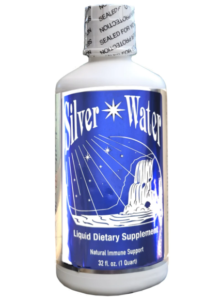The FDA’s stance on the therapeutic value of silver has long been a topic of debate, with many arguing that the agency’s position protects the interests of pharmaceutical giants. In contrast, the EPA permits the widespread use of silver as a germ-killing agent in various consumer products. This discrepancy raises questions about the true potential of silver as a therapeutic agent.
A History of Silver’s Antimicrobial Use
Silver’s antimicrobial properties have been recognized for centuries, leading to the use of silver utensils and containers. However, recent developments in nanotechnology have given rise to nano silver, which involves creating silver particles smaller than 100 nanometers (a billionth of a meter) in size. These minuscule particles have the potential to penetrate areas of the body that larger silver particles cannot, thereby increasing silver’s antimicrobial efficacy. Nevertheless, the downsides of nanosilver, including potential misuse, have sparked concerns.
Nanosilver: Promise and Controversy
The use of nanosilver has raised both hopes and concerns. The Natural Resources Defense Council (NRDC) took legal action in 2012 to challenge the EPA’s approval of nanosilver without comprehensive data on its potential risks. Critics argue that frivolous uses of nanosilver in products like bedding and clothing for odor prevention could overshadow its important therapeutic applications.
The Multifaceted Attack of Silver
Silver’s antimicrobial effectiveness is attributed to its ability to attack bacteria through three distinct mechanisms:
- Weakening Cell Walls: Silver weakens bacterial cell walls, causing them to collapse or burst.
- Enzyme Interference: It disrupts the enzymes that bacteria rely on to metabolize nutrients, effectively starving them.
- Replication Disruption: Silver interferes with bacteria’s ability to replicate.
This three-pronged approach makes it challenging for bacteria to develop resistance to silver, although not entirely impossible.
A Path Towards Antibiotic Resistance Mitigation
The weakening of bacterial cell walls by silver also facilitates the entry of conventional antibiotics, reducing the necessary dosage. Research conducted at Boston University on mice demonstrated that adding silver to antibiotics lowered the required antibiotic doses and even reversed antibiotic resistance in E. coli bacteria, rendering them susceptible to tetracycline. Importantly, the mice remained unharmed by the silver treatment.
This development is significant as it may compel medical authorities to reevaluate silver as a therapeutic agent. Furthermore, it could hold the key to addressing the growing problem of antibiotic-resistant diseases.
Therapeutic Applications and Effectiveness
Numerous studies have highlighted silver’s therapeutic potential. It has demonstrated powerful effects against various infections, including thrush, pericoronitis, E. coli, and Staphylococcus aureus. In cattle, silver nanoparticles in blood serum displayed highly potent antibacterial activity against certain strains. Despite this growing body of evidence, the FDA has not recognized colloidal silver (silver suspended in a liquid) as a safe and effective antibiotic since 1996.
However, scientific studies challenge this stance. Research indicates that ionic colloidal silver is highly effective at killing bacteria, contradicting the FDA’s claims. The potential for silver to act as an antibacterial agent with low human toxicity has also been acknowledged.
Silver’s Role in Combatting Tuberculosis and Viruses
Tuberculosis, particularly multi-drug-resistant TB, presents a significant global health challenge. Silver’s effectiveness against TB and its lack of known resistance mechanisms make it a potential tool in the fight against this disease.
Silver nanoparticles have also shown promise in combatting viral infections, including HIV, hepatitis B, and the H1N1 influenza A virus. Coating condoms with silver nanoparticles has inactivated HIV and herpes simplex viruses, and silver-enhanced water filters have proven more effective at removing viruses from drinking water.
Is Colloidal Silver Safe?
Colloidal silver appears safe for use by individuals and families when used according to manufacturer instructions. However, care should be taken to avoid overdosing. It is generally advisable to reserve silver for more serious infections rather than everyday issues like acne.
The Quest for Purity: Wayne Rowland’s Silver Water
In the realm of colloidal silver, Wayne Rowland’s Silver Water stands out. Produced through a cutting-edge process that creates monatomic particles of ionic silver, it has a 20-year history of success. Wayne Rowland’s dedication to perfecting this process has resulted in a product with hundreds of thousands of satisfied customers. This Silver Water is considered to enhance the body’s natural defense system.
Wayne Rowland built a state-of-the-art Tesla lightning type machine to produce his unique brand of silver water. Rowland’s Silver Water is known by many names, Wain Water, B-flat water, magic water, and others. This water is tested batch after batch and certified pure and crystal clear.
Wayne Rowland, the inventor of this silver water process has spent millions of dollars using Tesla and Rife technologies and 22 years on perfecting the process resulting in his B-flat resonance silver water.
FDA’s Controversial Position
Despite mounting evidence supporting silver’s antimicrobial properties and therapeutic potential, the FDA maintains its stance against recognizing silver as a safe and effective antibiotic. Critics argue that the agency’s reluctance may be influenced by the fact that silver, as a natural substance, is not easily patentable. Consequently, there is limited financial incentive for companies to invest the substantial funds required for FDA approval. This situation has raised concerns about the potential consequences for public health, especially as antibiotic-resistant diseases continue to proliferate.
In conclusion, the controversy surrounding silver’s therapeutic value persists, with proponents highlighting its potential as a powerful antimicrobial and critics questioning the FDA’s stance. The ongoing debate underscores the need for comprehensive research and regulatory clarity regarding silver’s role in healthcare.

